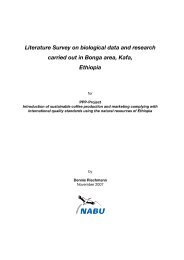Flora Biodiversity Assessment in Bonga, Boginda and Mankira Forest
Flora Biodiversity Assessment in Bonga, Boginda and Mankira Forest
Flora Biodiversity Assessment in Bonga, Boginda and Mankira Forest
Create successful ePaper yourself
Turn your PDF publications into a flip-book with our unique Google optimized e-Paper software.
2002 recorded very low number of seedl<strong>in</strong>gs, 5888, which is almost 10 times less than<br />
the current survey.<br />
A total of 30 species <strong>in</strong> <strong>Mankira</strong>, 36 species <strong>in</strong> Bog<strong>in</strong>da <strong>and</strong> 57 species <strong>in</strong> <strong>Bonga</strong> are<br />
recorded as regeneration. Getachew Berhane <strong>and</strong> Yoseph Assefa <strong>in</strong> IBC, 2002 recorded<br />
27 species for Bog<strong>in</strong>da forest. The result is quite comparable. Ensermu Kelbessa <strong>and</strong><br />
Teshome Soromessa, 2004 reported that 25 species were not represented as regeneration<br />
<strong>in</strong> <strong>Bonga</strong> forest (out of 57). In the current survey 61.4 percent of trees hav<strong>in</strong>g dbh greater<br />
or equal to 10 cm are represented as regeneration <strong>in</strong> <strong>Bonga</strong>. In Bog<strong>in</strong>da 52.8 percent of<br />
trees/shrubs hav<strong>in</strong>g 10 cm <strong>and</strong> above are recorded as regeneration, whereas <strong>in</strong> <strong>Mankira</strong>,<br />
43.5 percent of trees greater than 10 cm dbh are represented as regeneration.<br />
Species such as Cordia africana are not registered as regeneration with<strong>in</strong> the three forest<br />
areas. Probably this is because the species is an early colonizer (Friis, 1992). Croton<br />
macrostacheys too, as pioneer species (light dem<strong>and</strong><strong>in</strong>g), does not encounter adequate<br />
conditions for regeneration <strong>in</strong> a natural forest (Denich, 2006). But on road sides <strong>and</strong><br />
wherever there is an open<strong>in</strong>g, Croton is well grown <strong>and</strong> observed <strong>in</strong> many places. Ficus<br />
species are also not represented <strong>in</strong> regeneration except F. palmata <strong>in</strong> <strong>Mankira</strong>.<br />
From the upper canopy species (Pouteria adolfi-friederici, Ficus species, Syzygium<br />
gu<strong>in</strong>eense, Olea welwitschii, Trilepisium madagascariense, Schefflera volkensii <strong>and</strong><br />
Hagenia abyss<strong>in</strong>ica), Pouteria adolfi-friederici is represented as regeneration with<strong>in</strong> the<br />
three study sites. Trilepisium madagascariense is represented as regeneration with<strong>in</strong> two<br />
of the study sites, <strong>in</strong> <strong>Bonga</strong> <strong>and</strong> Bog<strong>in</strong>da. Syzygium gu<strong>in</strong>eense <strong>and</strong> Olea welwitschii are<br />
represented as regeneration <strong>in</strong> one study site only, <strong>in</strong> Bog<strong>in</strong>da <strong>and</strong> <strong>Bonga</strong>, respectively.<br />
4.3.4 Sapl<strong>in</strong>gs per hectare<br />
Density of sapl<strong>in</strong>gs recorded are 4332 <strong>in</strong> <strong>Bonga</strong>, 11156 <strong>in</strong> Bog<strong>in</strong>da <strong>and</strong> 12796 <strong>in</strong><br />
<strong>Mankira</strong>. Density of sapl<strong>in</strong>gs <strong>in</strong> Bog<strong>in</strong>da <strong>and</strong> <strong>Mankira</strong> are comparable but lesser number<br />
of tree sapl<strong>in</strong>gs is recorded <strong>in</strong> <strong>Bonga</strong>. The reason could be that s<strong>in</strong>ce <strong>Bonga</strong> forest is <strong>in</strong><br />
general denser than the other two forests (refer section 4.3.2), competition might limit<br />
emergence/performance of sapl<strong>in</strong>gs. But with regard to number of trees above 10 cm dbh<br />
48



